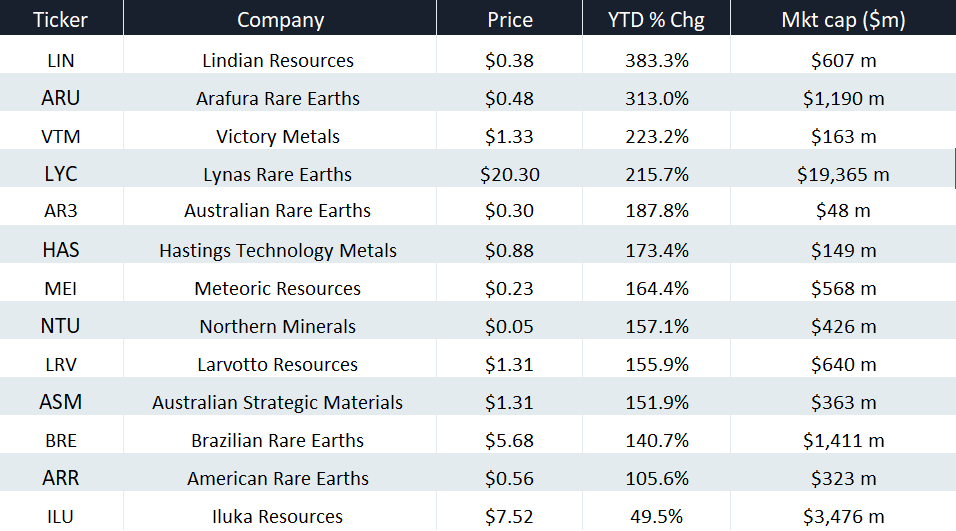What ASX rare earths stocks could Trump buy?
As Anthony Albanese departs Washington after meeting Donald Trump, the two leaders have sealed a landmark deal to jointly fund critical minerals projects - a move that marks a new phase in the U.S.–Australia alliance.
Trump’s new playbook: Investing for control
The Trump administration has redefined industrial policy by investing directly in strategic companies.
Through the Department of Defense and Department of Energy, Washington has already taken stakes in MP Materials (NYSE: MP), and Canada's Lithium Americas (TSE: LAC), and Trilogy Metals (TSE: TMQ) - a series of deals designed to rebuild domestic control over supply chains vital to national security.
The logic is simple: the US is almost entirely dependent on China for the processing of rare earths and key battery metals. Beijing still supplies about 70% of US rare earth imports and controls nearly 90% of processing capacity, giving it enormous leverage over industries from EVs and semiconductors to weapons systems.
Trump’s response has been what analysts call “strategic capitalism”, a deliberate break from free-market orthodoxy in favour of state-backed investment. The goal: to secure supply chains, reindustrialise the US, and protect critical industries from geopolitical shocks.
Australia’s role in the new critical minerals pact
Australia, like Canada, has emerged as a key pillar of that strategy.
Albanese’s meeting with Trump, accompanied by Resources Minister Madeleine King and Industry and Innovation Minister Tim Ayres, delivered a breakthrough: both governments agreed to jointly fund critical minerals projects - at least six of which are in Australia - reinforcing that state-backed investment is now central to the U.S. and Australia’s plan to counter China’s dominance of supply chains.
And the timing could not be more pertinent.
Just as Albanese arrived in Washington, NSW-based Larvotto Resources (ASX: LRV) received a $723 million takeover bid from United States Antimony Company (NYSE: UAMY), one of America’s fastest-rising critical minerals players. The all-scrip deal represents an 86.6% premium to the undisturbed closing price of 75 cents on 30 September, 2025.
While non-binding, the proposal highlights growing US appetite for Australian assets, and suggests that Washington’s next wave of strategic investments may come from both public and private channels.
Which ASX stocks could be of interest?
.jpg)
According to Emanuel Datt, Founder of Datt Capital, US interest in Australian rare earth producers is out of necessity.
“The White House has explicitly signalled a shift toward taking equity stakes in ‘strategic’ supply chains to counter China,” says Datt.
“This demonstrates that the U.S. is taking critical steps to reduce its reliance on Chinese supply chains to enhance its strategic security.”
He believes the decoupling of Western and Asian supply chains will be gradual but genuine - a sustained effort to diversify rare earth sourcing over time.
So, which ASX companies fit the U.S. playbook for investment? Datt reckons the Trump Administration is likely eyeing the following three contenders:
- Lynas (ASX: LYC) is the world's premier rare earth producer (ex-China), so is the most obvious candidate for US investment. Lynas valuation has risen sharply given its asset quality and status as a well-established rare earth producer.
- Iluka (ASX: ILU) is a mining business currently developing a rare earth refinery in a partnership with the Australian government. The company has tied up a number of supply agreements for rare earth ores that will provide a diversified source of feedstock for the refinery.
- Arafura Rare Earths (ASX: ARU) is an advanced rare earth developer with deposits in the Northern Territory. This is an earlier stage exposure than LYC and ILU.
Datt adds that his funds are “diversified across existing producers and high-quality developers,” with one favoured exposure being WA1 Resources (ASX: WA1), a niobium-focused developer he describes as holding “a highly valuable, extremely strategic compound used in advanced defence applications.”
"In the current market environment, we think of rare earth exposures as bearing upside from a lower cost of capital, offtake certainty and a geopolitical premium for well located assets," he says.
YTD performance of rare earths stocks
With interest in the sector heating up, here's a list of ASX-listed rare earth and critical mineral companies that the White House could be running its ruler over. It’s intended as a starting point for further research, not a definitive list of targets.

As evident from recent performance, valuations across the sector have already run hot. There’s no guarantee a deal will eventuate, and sentiment in the space remains notoriously volatile - shifting quickly with every policy move or geopolitical headline.
2 topics
4 stocks mentioned
1 contributor mentioned

